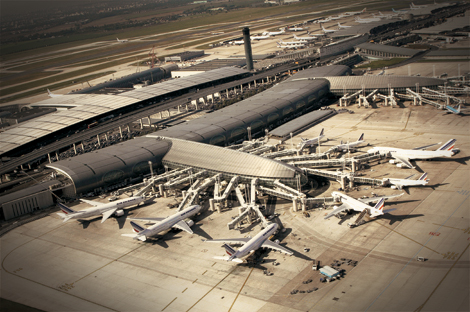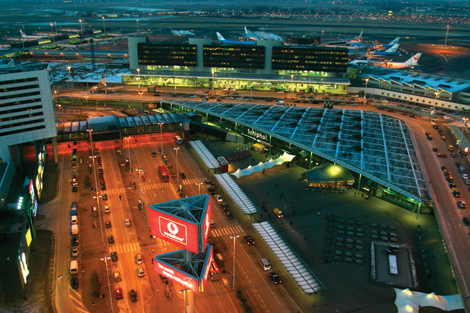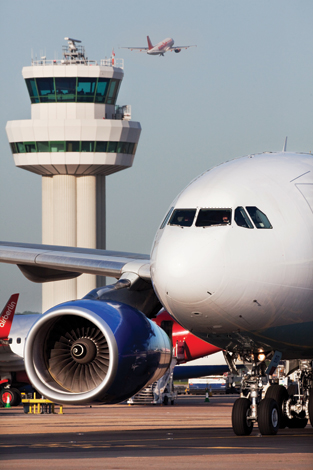Charles de Gaulle
For first-time visitors to Charles de Gaulle (CDG), it can be slightly disconcerting as you descend to see another aircraft mirroring your approach. CDG airport occupies a huge area, almost one-third the size of the city of Paris itself, yet with four runways it has room to spare and can land planes simultaneously.
Earlier this year, the French airport celebrated its 40th anniversary. It is the second-busiest airport in Europe, after Heathrow (with its two runways), and the eighth-busiest worldwide in terms of traffic, with 62 million passengers passing through in 2013.
The airport has room for expansion, however, with a capacity of 80 million, useful when annual traffic growth worldwide is expected to rise by about 3-5 per cent per annum over the next 20 years, according to the International Air Transport Association (IATA).
Charles de Gaulle isn’t the only Paris airport – there are several, including Paris Orly, which also receives international passenger flights – but it is CDG that hosts the global hub of Air France-KLM and is the principal European hub of the Skyteam alliance. Some 60 per cent of passengers are connecting, flying into the airport only to continue on to their eventual destination.
Terminal 1 is home to Star Alliance member airlines, while Terminal 2 brings together carriers belonging to Oneworld and Skyteam, with Skyteam-operated intercontinental flights making up more than 60 per cent of CDG’s traffic and more than 80 per cent in Terminal 2.

All of this sounds a little abstract until you land at the airport. Suddenly you are faced with giant boards filled with seemingly hundreds of departing flights, and directional arrows in both French and English pointing you to different parts of the building. For leisure travellers, it’s an extra bit of stress. For business travellers, who often have a choice over their airline and routing, it can be a deal breaker.
Charles de Gaulle recognises this, and wants to attract business travellers, even having a special section on the Aéroports de Paris website promoting initiatives such as the Parafe programme (visit tinyurl.com/q2jvjds). This allows you to pass through border control with just your passport and fingerprints (like the e-passport gates at London Heathrow) and is available to European Union citizens, including those from the UK. (You need to pre-register.)
If you are a frequent flyer and have status with Skyteam, then you will no doubt be on the look-out for Sky Priority areas, where first class, business, Club 2000, Flying Blue, Elite Plus and other eligible members can take advantage of fast-track lines to go through security.
Having travelled through the airport twice recently, it’s clear to me that, as with many airport hubs, the minimum connection time (MCT) is something you might want to add padding to. At Charles de Gaulle, depending on route, security, the location of the terminals and the distance between them, it can be anything from 60 to 90 minutes, although the airport itself refuses to specify a MCT.
The challenge for Charles de Gaulle is meeting 21st century requirements with an airport planned and built in the 20th century. The addition of security, huge passenger numbers and myriad new airlines serving new traffic flows has meant the airport has kept expanding. But this enviable size – and the capacity to become even larger – has to be made manageable and understandable to passengers, and every piece of new infrastructure has to be slotted in and around what already exists.
Charles de Gaulle is now also concentrating on the connections into Paris (to Gare de l’Est station) with its CDG Express construction project. Work is due to begin in 2017, and the line should be operational to the public in 2023.
Like most hubs, Charles de Gaulle is a work in progress, but at least the progress continues.
Charles de Gaulle, Paris by Tom Otley
PARIS CHARLES DE GAULLE IN NUMBERS
2nd BUSIEST AIRPORT IN EUROPE
8th BUSIEST WORLDWIDE
4 RUNWAYS
9 PASSENGER TERMINALS
180 AIRLINES
315 CITIES SERVED
61.6 MILLION PASSENGERS
391 SHOPS, BARS AND RESTAURANTS
• 600,000 EIFFEL TOWER SOUVENIRS SOLD EVERY YEAR
• 1 MILLION BOTTLES OF WINE
• 400,000 BOTTLES OF CHAMPAGNE
• 400,000 CHEESES
• 250,000 UNITS OF FOIE GRAS
HELSINKI
If you had to design a perfect hub airport, Helsinki would come close. First, it is small – much smaller than most hubs, and smaller than many airports that have no aspirations to be a hub.
Located under one roof (the airport map shows two terminals, but it’s still effectively one building), Helsinki served 15 million passengers in 2013 and is aiming for 20 million by 2020. With three operational runways, it has plenty of capacity to spare, and firm plans for expanding its operations.
Second, it’s reliable. Despite sharing a latitude with Anchorage in Alaska, it has closed only once in the past ten years or so – for less than an hour in 2003, owing to a snowstorm. It also boasts of having 98.5 per cent on-time departures, although these figures are from the airport, which records only delays that it is responsible for. Flight data specialist OAG rates punctuality at the airport as “average”.
Third, it is focused on being a hub. Yes, it offers plenty of direct flights, both for those flying to and from Helsinki within the region and Europe as a whole, but its main strategic objective is connecting traffic. As chief executive Kari Savolainen says: “Finland does not have a big enough domestic population for point-to-point traffic to be the real focus for us.”
Instead, it encourages airlines to use it as a hub by keeping its costs down, partly because it owns the airport land, and partly through efficiency, offering short minimum connection times of 25-40 minutes depending on the route details.
Fourth is its location. Savolainen points out that the focus on connecting traffic is an obvious one “when you look at the map”. “Within 12 hours’ flight from the airport, look at where you can reach,” he says. “We are an epicentre for Asia, but also for Russia. St Petersburg is only three or four hours from Helsinki, so it’s in our catchment area.” Helsinki is in the right place for European travellers wishing to fly to Asia, being positioned on the Great Circle Route between the continents.
The shared aims of Finnair and the airport to capture Asian traffic provide Helsinki’s fifth key advantage. The two work together more closely than, for instance, Heathrow and British Airways are ever likely to, and since half of Finnair’s capacity is on Asian routes, airline president and chief executive Pekka Vauramo is unequivocal about the airport’s importance.
When I interviewed him earlier this year, he even admitted that for most travellers, Finnair’s product was “a transfer via Helsinki”. Yes, the fully-flat bed being rolled out across the airline’s business class cabins is important, as is the Finnish design aesthetic, and good food and wine on board. In the end, however, it’s quick transfer times, competitive prices and a hub that facilitates journeys to and from Asia that are the main selling points.
The airport is, of course, aware of the importance not only of being an efficient hub, but also of marketing itself as such. It is a small airport, not only in worldwide terms but even in Europe. OAG ranks the airport 27th in terms of the number of flights it operates, and 31st in terms of the number of seats it offers (although this reflects the slightly smaller aircraft sizes operated).
The facilities are constantly being improved, and, certainly for top-tier passengers with access to the lounges, the recent upgrade has made a good situation even better. The sauna in the Finnair lounge may be another gimmick (nothing wrong with that), but the lounges are clean, large and easy to reach from everywhere in the airport.
It’s an enviable position to have spare capacity, the political will for expansion and a clear strategy supported by the national airline. Helsinki is determined to remain an attractive international hub, and has outlined an expansion programme continuing until 2020. The main point is that transfer traffic capacity will be increased while remaining under one roof, “keeping distances short and services easily accessible and provid[ing] a customer-friendly airport experience”, as the proposal puts it. The initiative has three stages.
1. Finavia (the airport owner) will enlarge the facilities for long-haul passengers and increase the number of spots for wide-bodied aircraft for transit traffic.
2. Transit capacity will then be further increased and the service level for European and domestic flights improved.
3. Terminal 2 will be expanded so that check-in, security control and baggage drop will all take place in one departure/arrival hall.
In addition, train services from central Helsinki, located about 20km south of the airport, will start in July.
Helsinki by Tom Otley
HELSINKI IN NUMBERS
15 MILLION PASSENGERS (2013)
2 MILLION TRANSFERRING PASSENGERS
1 MILLION TRANSFERRING TO AND FROM ASIA
130 DIRECT FLIGHTS
12 DAILY CONNECTING FLIGHTS TO ASIA
MINIMUM CONNECTING TIMES:
• FLIGHTS WITHIN FINLAND: 25–35 MINUTES
• WITHIN SCHENGEN AREA: 35 MINUTES
• FROM SCHENGEN TO NON-SCHENGEN AREA: 40 MINUTES
Schiphol
Schiphol has five runways, no slot constraints and yet more room to grow – and is steadily building global connections for passengers across the world. The Dutch hub has a strong worldwide network of 323 direct destinations in 99 countries, of which about 140 services are intercontinental. It’s no wonder many business travellers in the region are choosing to route through Amsterdam. In 2014, Schiphol was named Best Airport in Europe at the Business Traveller Awards for the
25th time.
It’s perhaps no surprise that a country built on global trade and exploration founded its airport with the key aim of providing “connectivity to compete”, as Jos Nijhuis, president and chief executive of Schipol, terms it.
“The Netherlands is a small country so connectivity is key for our economy,” he explains. “Almost every business in the Netherlands is international because the domestic market is too small. To be able to offer this amount of intercontinental destinations, we need to have the transfer passenger, and that’s the whole business model of [Dutch flag carrier] KLM, which it has developed over the past 95 years. We have designed the airport according to that, because we have always understood that connectivity is so important.”
Schiphol is certainly purpose-built to serve transfer traffic, and more than 40 per cent of travellers using the airport are connecting to another flight. Its one-terminal concept helps the airport to minimise connecting times. While some may argue that walking distances can be longer as a result, way-finding is excellent. Intercontinental services operated by KLM and its Skyteam partners are grouped in piers D, E and F, near the centre of the terminal, to keep flights close together. Flights are also organised in waves throughout the day to optimise the number of global links the airport can offer.
The airport environment itself, meanwhile, is among the most imaginative you will find anywhere. The rest areas are inspired by nature (complete with trees and tweeting birds), there’s a roof terrace, public art, a library, numerous Dutch touches – from a tulip shop set inside a greenhouse to a choose-your-own Bols cocktail station – and even a mini Rijksmuseum.

Major renovations of Departure Lounge 2 are now going on, which will increase the amount of retail and food and beverage space by 20 per cent. New retail outlets will include a flagship Johnnie Walker House store and a Gucci boutique. The area remains open while the works are taking place – they are scheduled to be completed by summer 2015.
The revamp in departures is part of the airport’s master plan to boost capacity from 52.6 million annual passengers (2013 figure) to 65 million in the next five years, with the ability to go to 80 million if necessary. This includes adding another pier and extending the terminal (both due to be ready by 2018) and building a new Hilton hotel (to open in mid-2015).
One of the main parts of the project, now well under way, is the introduction of centralised security areas to replace the airport’s at-gate checkpoints – currently a bugbear for many travellers.
“We are one of the few airports with decentralised security and have waited a bit too long in changing that,” Nijhuis concedes. “It’s a huge project. We are in the middle of the refurbishments and it should be ready on June 3, 2015.”
There will be five central security zones – one of which, for Schengen passengers departing Amsterdam, is already open. The area has been designed so that experienced travellers can bypass those who need more time to prepare for scanning. Bags that fail the scan are passed through a dedicated machine, rather than being fed back through the same one, so as not to slow down the process.
The airport aims to keep security queuing time at peak periods to no more than five minutes for premium passengers and ten for other travellers. This should also have a knock-on effect on overall connections. The minimum connecting time at the airport for intercontinental flights is 50 minutes (although some contributors to our online forum have suggested this can be too short for passengers – and their baggage – to make their next flight: businesstraveller.com/discussion).
KLM’s flagship intercontinental Crown lounge is also being transformed (it remains open during the refurbishment). Currently 3,600 sqm with more than 800 seats, it will almost double in size. “Right now, the lounge is good but it doesn’t give you a wow effect,” Maarten Koopmans, vice president, passenger services at KLM says. “Since we are a transfer carrier aiming to draw customers to Schiphol, we want to offer something special there. It’s a big project – it will take two years – but we should then have one of the best lounges in the world.”
Schiphol by Michelle Harbi
SCHIPHOL IN NUMBERS
FOURTH-LARGEST EUROPEAN AIRPORT
FIVE MAIN RUNWAYS
26 UK AIRPORTS SERVED
87 RESTAURANTS
111 SHOPS
OVER 40% PASSENGERS TRANSFERRING
65-70% KLM PASSENGERS TRANSFERRING
323 DIRECT DESTINATIONS
40,000 CONNECTIONS WITH KLM/SKYTEAM
650,000 SQM TERMINAL AREA
52.6 MILLION PASSENGERS IN 2013
1.5 MILLION BEING INVESTED IN THE AIRPORT DAILY 2014-16
Gatwick
Operating for more than 50 years, Gatwick has two terminals (North and South), serves more than 200 destinations and sees an average of 55 take-offs and landings per hour on just one strip of tarmac. In 2009, it was bought by GIP (Global Infrastructure Partners), which proceeded to pump £1.2 billion (US$1.9 billion) worth of investment into upgrading it, from installing cutting-edge technology to putting together a bid for a second runway.
Infrastructure has been a big focus of the renovations, with the unveiling of a £6.4 million (US$10.1 million) A380 stand (110) for the launch of Emirates’ superjumbo flights to Dubai at Pier Six in the North Terminal in March 2014, while Pier Five is also undergoing refurbishments to be unveiled in
the summer.
The security area in the South Terminal has also undergone a major revamp aimed at enabling all passengers to pass through within five minutes. “Anonymous face recognition” cameras that photograph passengers at each stage of the process allow the airport to monitor whether that target is being reached. The same technology has been fitted in immigration, which now has 15 e-gates for people with biometric passports.
In terms of leisure facilities, the South Terminal underwent a £41 million (US$64.4 million) retail overhaul in 2013, with 22 new or refreshed stores opening including Armani, Harrods and World of Whiskies. The new landside Bloc hotel opened in April and offers 244 rooms with free wifi, double beds, walk-in rain showers and automatic checkout facility.

For business people, Regus Express opened a landside lounge next to the Yotel last October. It also introduced a number of 4 sqm private “workboxes” airside in both terminals, equipped with printers, computers, phones and wifi. In July, No 1 Traveller (no1traveller.com) opened a second Gatwick facility called My Lounge. The “loft-inspired” venue seats 50 guests and offers free wifi, snacks plus fast-track security access.
Since May, the airport has been trialling an innovative new service called Gatwick Connect, designed to help passengers transferring from one airline to another. Instead of having to check your bag in for a second time, you can leave it at the Gatwick Connect desks in baggage reclaim, where staff will process it for your connecting flight and issue an onward boarding pass.
Connectivity is also getting an overhaul. Two train operators – Southern and First Capital Connect – currently offer services to the South Terminal from London Victoria and London Bridge, but from July these will be combined under a new Govia Thameslink “super-franchise”, known as TSGN, that also encompasses Gatwick Express and will run 24 hours. By 2019 there will be a train leaving Gatwick for central London once every two and a half minutes.
Gatwick is also very eager to expand and has gone head-to-head with Heathrow in bidding for an additional runway to increase passenger volumes from 38 million to 95 million a year by 2025 and boost overall UK airport capacity.
Gatwick by Jenny Southan
GATWICK IN NUMBERS
36 MILLION PASSENGERS A YEAR
1 RUNWAY
2 TERMINALS
45 AIRLINES
200 DESTINATIONS
115 AIRCRAFT STANDS
346 CHECK-IN DESKS
1 IN 5 PASSENGERS ARE BUSINESS TRAVELLERS








